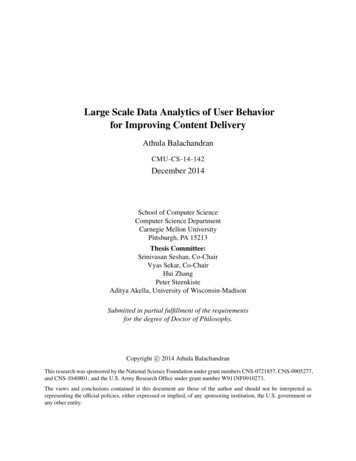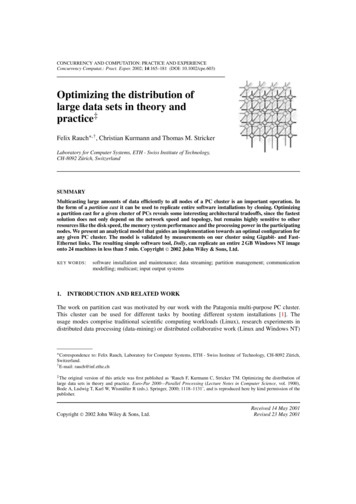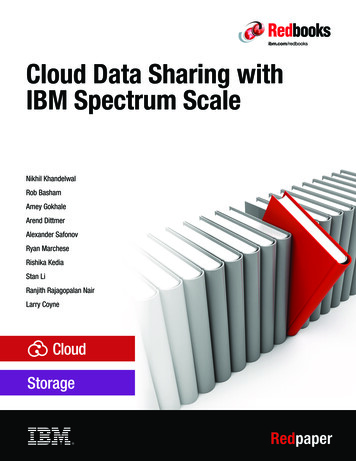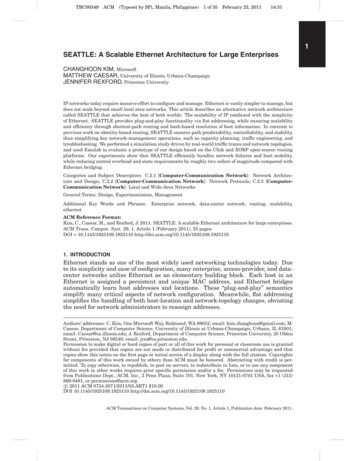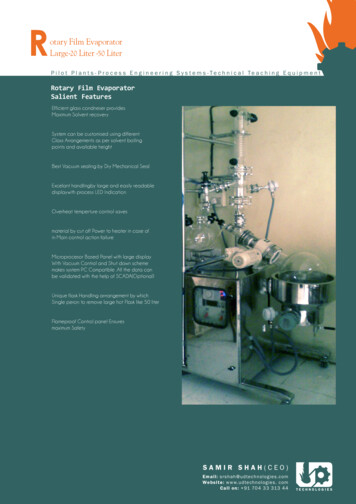
Transcription
Large-Scale Data EngineeringFrameworks Beyond MapReduceevent.cwi.nl/lsde
THE HADOOP ECOSYSTEMwww.cwi.nl/ boncz/badsevent.cwi.nl/lsde
YARN: Hadoop version 2.0 Hadoop limitations:– Can only run MapReduce– What if we want to run other distributed frameworks? YARN Yet-Another-Resource-Negotiator– Provides API to develop any generic distribution application– Handles scheduling and resource request– MapReduce (MR2) is one such application in YARNwww.cwi.nl/ boncz/badsevent.cwi.nl/lsde
YARN: architecturewww.cwi.nl/ boncz/badsevent.cwi.nl/lsde
The Hadoop Ecosystemfast in-memoryprocessinggraphanalysisImpalamachine learningHCATALOGMLIBdata queryinggraphXSparkSQLYARNwww.cwi.nl/ boncz/badsevent.cwi.nl/lsde
The Hadoop Ecosystem Basic services– HDFS Open-source GFS clone originally funded by Yahoo– MapReduce Open-source MapReduce implementation (Java,Python)– YARN Resource manager to share clusters between MapReduce and other tools– HCATALOG Meta-data repository for registering datasets available on HDFS (Hive Catalog)– Cascading Dataflow tool for creating multi-MapReduce job dataflows (Driven GUI for it)– Spark new in-memory MapReduce based on Scala (avoids HDFS writes) Data Querying– Pig Relational Algebra system that compiles to MapReduce– Hive SQL system that compiles to MapReduce(Hortonworks)– Impala, or, Drill efficient SQL systems that do *not* use MapReduce(Cloudera,MapR)– SparkSQL SQL system running on top of Spark Graph Processing– Giraph Pregel clone on Hadoop(Facebook)– GraphX graph analysis library of Spark Machine Learning– Okapi Giraph –based library of machine learning algorithms (graph-oriented)– Mahout MapReduce-based library of machine learning algorithms– MLib Spark –based library of machine learning algorithmswww.cwi.nl/ boncz/badsevent.cwi.nl/lsde
HIGH-LEVEL WORKFLOWSHIVE & PIGwww.cwi.nl/ boncz/badsevent.cwi.nl/lsde
Need for high-level languages Hadoop is great for large-data processing!– But writing Java/Python/ programs for everything is verbose and slow– Cumbersome to work with multi-step processes– “Data scientists” don’t want to / can not write Java Solution: develop higher-level data processing languages– Hive: HQL is like SQL– Pig: Pig Latin is a bit like Perlwww.cwi.nl/ boncz/badsevent.cwi.nl/lsde
Hive and Pig Hive: data warehousing application in Hadoop– Query language is HQL, variant of SQL– Tables stored on HDFS with different encodings– Developed by Facebook, now open source Pig: large-scale data processing system– Scripts are written in Pig Latin, a dataflow language– Programmer focuses on data transformations– Developed by Yahoo!, now open source Common idea:– Provide higher-level language to facilitate large-data processing– Higher-level language “compiles down” to Hadoop jobswww.cwi.nl/ boncz/badsevent.cwi.nl/lsde
Hive: example Hive looks similar to an SQL database Relational join on two tables:– Table of word counts from Shakespeare collection– Table of word counts from the bibleSELECT s.word, s.freq, k.freq FROM shakespeare sJOIN bible k ON (s.word k.word) WHERE s.freq 1 AND k.freq 1ORDER BY s.freq DESC LIMIT 727204135124456884www.cwi.nl/ boncz/badsevent.cwi.nl/lsdeSource: Material drawn from Cloudera training VM
Hive: behind the scenesSELECT s.word, s.freq, k.freq FROM shakespeare sJOIN bible k ON (s.word k.word) WHERE s.freq 1 AND k.freq 1ORDER BY s.freq DESC LIMIT 10;abstract syntax tree(TOK QUERY (TOK FROM (TOK JOIN (TOK TABREF shakespeare s) (TOK TABREF bible k) ( (. (TOK TABLE OR COLs) word) (. (TOK TABLE OR COL k) word)))) (TOK INSERT (TOK DESTINATION (TOK DIR TOK TMP FILE))(TOK SELECT (TOK SELEXPR (. (TOK TABLE OR COL s) word)) (TOK SELEXPR (. (TOK TABLE OR COL s) freq))(TOK SELEXPR (. (TOK TABLE OR COL k) freq))) (TOK WHERE (AND ( (. (TOK TABLE OR COL s) freq) 1) ( (. (TOK TABLE OR COL k) freq) 1))) (TOK ORDERBY (TOK TABSORTCOLNAMEDESC (. (TOK TABLE OR COL s) freq)))(TOK LIMIT 10)))one or more of MapReduce jobswww.cwi.nl/ boncz/badsevent.cwi.nl/lsde
Pig: exampleTask: Find the top 10 most visited pages in each categoryVisitsUrl omSports0.9www.cwi.nl/ boncz/badsevent.cwi.nl/lsdePig Slides adapted from Olston et al. (SIGMOD 2008)
Pig query planLoad VisitsGroup by urlForeach urlgenerate countLoad Url InfoJoin on urlGroup by categoryForeach categorygenerate top10(urls)www.cwi.nl/ boncz/badsevent.cwi.nl/lsdePig Slides adapted from Olston et al. (SIGMOD 2008)
Pig scriptvisits load ‘/data/visits’ as (user, url, time);gVisits group visits by url;visitCounts foreach gVisits generate url, count(visits);urlInfo load ‘/data/urlInfo’ as (url, category, pRank);visitCounts join visitCounts by url, urlInfo by url;gCategories group visitCounts by category;topUrls foreach gCategories generate top(visitCounts,10);store topUrls into ‘/data/topUrls’;www.cwi.nl/ boncz/badsevent.cwi.nl/lsdePig Slides adapted from Olston et al. (SIGMOD 2008)
Pig query planMap1Load VisitsGroup by urlReduce1Foreach urlgenerate countMap2Load Url InfoJoin on urlGroup by categoryForeach categorygenerate top10(urls)www.cwi.nl/ boncz/badsevent.cwi.nl/lsdePig Slides adapted from Olston et al. (SIGMOD 2008)
Digging further into Pig: basics Sequence of statements manipulating relations (aliases) Data model–Scalars (int, long, float, double, chararray, bytearray)–Tuples (ordered set of fields)–Bags (collection of tuples)www.cwi.nl/ boncz/badsevent.cwi.nl/lsde
Pig: common operations Loading/storing data–LOAD, STORE Working with data–FILTER, FOREACH, GROUP, JOIN, ORDER BY,LIMIT, Debugging–DUMP, DESCRIBE, EXPLAIN, ILLUSTRATEwww.cwi.nl/ boncz/badsevent.cwi.nl/lsde
Pig: LOAD/STORE dataA LOAD 'data' AS (a1:int,a2:int,a3:int);STORE A INTO 'data2’;STORE A INTO 's3://somebucket/data2';www.cwi.nl/ boncz/badsevent.cwi.nl/lsde
Pig: FILTER dataX FILTER A BY a3 3;(1,2,3)(4,3,3)(8,4,3)www.cwi.nl/ boncz/badsevent.cwi.nl/lsde
Pig: FOREACHX FOREACH A GENERATE a1, a2;X FOREACH A GENERATE a1 a2 AS f1:int;www.cwi.nl/ boncz/badsevent.cwi.nl/lsde
Pig: ORDER BY / LIMITX LIMIT A 2;(1,2,3)(4,2,1)X ORDER A BY wi.nl/ boncz/badsevent.cwi.nl/lsde
Pig: GROUPingG GROUP A BY (8,{(8,4,3),(8,3,4)})Bagswww.cwi.nl/ boncz/badsevent.cwi.nl/lsde
Pig: Dealing with grouped dataG GROUP A BY a1;R FOREACH G GENERATE group, COUNT(A);(1,1)(4,2)(7,1)(8,2)www.cwi.nl/ boncz/badsevent.cwi.nl/lsde
Pig: Dealing with grouped dataG GROUP A BY a1;R FOREACH G GENERATE group, SUM(A.a3);(1,3)(4,4)(7,5)(8,7)www.cwi.nl/ boncz/badsevent.cwi.nl/lsde
Pig: Dealing with grouped dataG GROUP A BY a1;R FOREACH G {O ORDER A BY a2;L LIMIT O 1;GENERATE (8,3,4)})www.cwi.nl/ boncz/badsevent.cwi.nl/lsde
Pig: JOINsA1 LOAD 'data' AS (a1:int,a2:int,a3:int);A2 LOAD 'data' AS (a1:int,a2:int,a3:int);J JOIN A1 BY a1, A2 BY nl/ boncz/badsevent.cwi.nl/lsde
Pig: DESCRIBE (Show Schema)DESCRIBE A;A: {a1: int,a2: int,a3: int}www.cwi.nl/ boncz/badsevent.cwi.nl/lsde
Pig: ILLUSTRATE (Show Lineage)G GROUP A BY a1;R FOREACH G GENERATE group, SUM(A.a3);ILLUSTRATE R;----------------------------------------------- A a1:int a2:int a3:int ----------------------------------------------- 8 4 3 8 3 4 ----------------------------- G group:int ----------------- 8 {} 8 {} ------------------ R group:int :long ------------------------------------ 8 7 ------------------------------------- www.cwi.nl/ boncz/badsevent.cwi.nl/lsde
Pig: DUMP (careful!)DUMP i.nl/ boncz/badsevent.cwi.nl/lsde
OK. Live Demohttp://demo.gethue.com Query Editors Piglines LOAD '/user/hue/pig/examples/data/midsummer.txt' as (text:CHARARRAY);words FOREACH lines GENERATE FLATTEN(TOKENIZE(text,' '));grouped GROUP words BY token;counted FOREACH grouped GENERATE group,COUNT(words) AS cnt;filtered FILTER counted BY cnt 40;ordered ORDER filtered BY cnt;DUMP ordered;EXPLAIN ordered;DESCRIBE ordered;www.cwi.nl/ boncz/badsevent.cwi.nl/lsde
Pig: EXPLAIN (Execution plan)EXPLAIN R;Map PlanG: Local Rearrange[tuple]{int}(false) ---R: New For Each(false,false)[bag] ---Pre Combiner Local Rearrange[tuple]{Unknown} ---A: New For Each(false,false,false)[bag] ---A: tin.PigStorage)Combine PlanG: Local Rearrange[tuple]{int}(false) ---R: New For Each(false,false)[bag] ---G: Package(CombinerPackager)[tuple]{int}Reduce PlanR: Store(fakefile:org.apache.pig.builtin.PigStorage) ---R: New For Each(false,false)[bag] ---G: Package(CombinerPackager)[tuple]{int}Global sort: falsewww.cwi.nl/ boncz/badsevent.cwi.nl/lsde
Pig UDFs User-defined functions:– Java– Python– JavaScript– Ruby UDFs make Pig arbitrarily extensible– Express core computations in UDFs– Take advantage of Pig as glue code for scale-out plumbingwww.cwi.nl/ boncz/badsevent.cwi.nl/lsde
PageRank in Pigprevious pagerank LOAD ‘ docs in’ USING PigStorage()AS (url: chararray, pagerank: float,links:{link: (url: chararray)});outbound pagerank FOREACH previous pagerankGENERATE pagerank / COUNT(links) AS pagerank,FLATTEN(links) AS to url;new pagerank FOREACH ( COGROUP outbound pagerankBY to url, previous pagerank BY url INNER )GENERATE group AS url,(1 – d) d * SUM(outbound pagerank.pagerank) ASpagerank,FLATTEN(previous pagerank.links) AS links;STORE new pagerank INTO ‘ docs out’ USING PigStorage();www.cwi.nl/ boncz/badsevent.cwi.nl/lsdeFrom: implementation-in-pig/
Iterative computation#!/usr/bin/pythonfrom org.apache.pig.scripting import *P Pig.compile(""" Pig part goes here """)params { ‘d’: ‘0.5’, ‘docs in’: ‘data/pagerank data simple’}for i in range(10):out "out/pagerank data " str(i 1)params["docs out"] outPig.fs("rmr " out)stats P.bind(params).runSingle()if not stats.isSuccessful():raise ‘failed’params["docs in"] outUuuugly!www.cwi.nl/ boncz/badsevent.cwi.nl/lsdeFrom: implementation-in-pig/
GOOGLE PREGEL &GIRAPH: LARGE-SCALE GRAPHPROCESSING ON HADOOPwww.cwi.nl/ boncz/badsevent.cwi.nl/lsde
Graphs are Simplewww.cwi.nl/ boncz/badsevent.cwi.nl/lsde
A Computer Networkwww.cwi.nl/ boncz/badsevent.cwi.nl/lsde
A Social Networkwww.cwi.nl/ boncz/badsevent.cwi.nl/lsde
Maps are Graphs as wellwww.cwi.nl/ boncz/badsevent.cwi.nl/lsde
Graphs are nasty. Each vertex depends on its neighbours, recursively. Recursive problems are nicely solved iteratively.www.cwi.nl/ boncz/badsevent.cwi.nl/lsde
PageRank in MapReduce Record: v i, pr, [ v j, ., v k ] Mapper: emits v j, pr / #neighbours Reducer: sums the partial valueswww.cwi.nl/ boncz/badsevent.cwi.nl/lsde
MapReduce DataFlow Each job is executed N times Job bootstrap Mappers send PR values and structure Extensive IO at input, shuffle & sort, outputwww.cwi.nl/ boncz/badsevent.cwi.nl/lsde
Pregel: computational model Based on Bulk Synchronous Parallel (BSP)– Computational units encoded in a directed graph– Computation proceeds in a series of supersteps– Message passing architecture Each vertex, at each superstep:– Receives messages directed at it from previous superstep– Executes a user-defined function (modifying state)– Emits messages to other vertices (for the next superstep) Termination:– A vertex can choose to deactivate itself– Is “woken up” if new messages received– Computation halts when all vertices are inactivewww.cwi.nl/ boncz/badsevent.cwi.nl/lsdeSource: Malewicz et al. (2010) Pregel: A System for Large-Scale Graph Processing. SIGMOD.
Pregelsuperstep tsuperstep t 1superstep t 2www.cwi.nl/ boncz/badsevent.cwi.nl/lsdeSource: Malewicz et al. (2010) Pregel: A System for Large-Scale Graph Processing. SIGMOD.
Pregel: implementation Master-Slave architecture– Vertices are hash partitioned (by default) and assigned to workers– Everything happens in memory Processing cycle– Master tells all workers to advance a single superstep– Worker delivers messages from previous superstep, executing vertexcomputation– Messages sent asynchronously (in batches)– Worker notifies master of number of active vertices Fault tolerance– Checkpointing– Heartbeat/revertwww.cwi.nl/ boncz/badsevent.cwi.nl/lsdeSource: Malewicz et al. (2010) Pregel: A System for Large-Scale Graph Processing. SIGMOD.
Vertex-centric APIwww.cwi.nl/ boncz/badsevent.cwi.nl/lsde
Shortest Pathswww.cwi.nl/ boncz/badsevent.cwi.nl/lsde
Shortest Pathswww.cwi.nl/ boncz/badsevent.cwi.nl/lsde
Shortest Pathswww.cwi.nl/ boncz/badsevent.cwi.nl/lsde
Shortest Pathswww.cwi.nl/ boncz/badsevent.cwi.nl/lsde
Shortest Pathswww.cwi.nl/ boncz/badsevent.cwi.nl/lsde
Shortest Pathsdef compute(vertex, messages):minValue Inf# float(‘Inf’)for m in messages:minValue min(minValue, m)if minValue vertex.getValue():vertex.setValue(minValue)for edge in vertex.getEdges():message minValue edge.getValue()sendMessage(edge.getTargetId(), message)vertex.voteToHalt()www.cwi.nl/ boncz/badsevent.cwi.nl/lsde
53www.cwi.nl/ boncz/badsevent
Source: Material drawn from Cloudera training VM SELECT s.word, s.freq, k.freq FROM shakespeare s JOIN bible k ON (s.word k.word) WHERE s.freq 1 AND k.freq 1 ORDER BY s.freq DESC LIMIT 10; the 25848 62394 I 23031 8854 and 19671 38985 to 18038 13526 of 16700 34654 a 14170 8057 you 12702 2720 my 11297 4135 in 10797 12445
